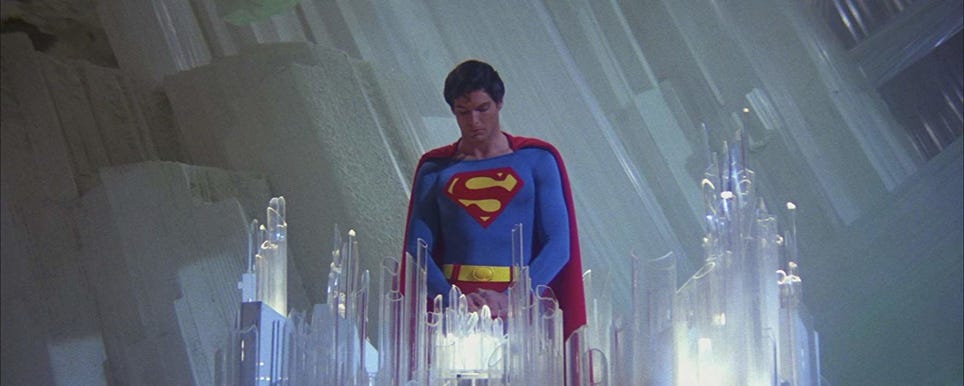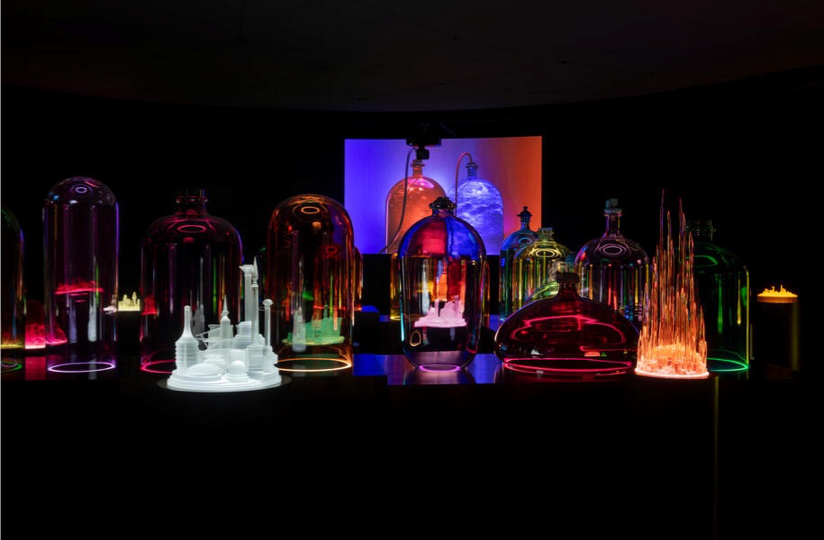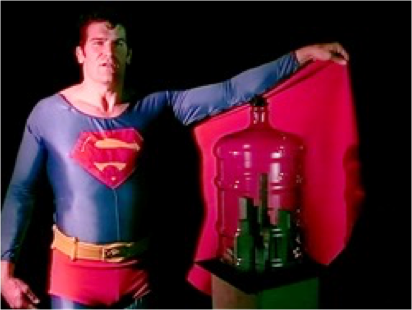This is a text I wrote for a workshop at Tate Modern organized by Larne Abse Gogarty and Naomi Vogt in January 2025 in connection with the Mike Kelley retrospective ‘Ghost and Spirit’.
*
Before I first visited the Mike Kelley exhibition at Tate Modern, the artworks I’d seen images of circulating on social media were the grubby melancholic cuddly toys from Half a Man but when I walked through the various rooms I found myself more drawn to the bright lights of Kandor.
A small cluster of turquoise rocks like luminescent ice crystals. An acid green disc covered in the glowing towers of an Oz-like city filled with radioactive skyscrapers. A weird blurry glittering multicoloured column of strange mineral-like gems under glass that looked as if it had been recently unearthed from a mystical mine. A pinkish grey cluster of translucent tendrils flickering upwards inside a purplish dome like a magical stalagmite chandelier. Huge video images of swirling atmospheres inside bell jars like giant enchanted snow globes. Esther Leslie notes that snow globes protect ‘a little world housed under glass’ and always present ‘an ideal scene, a composite or fantasy, a small image or imagined world that existed only in dreams.’ They are poised between the animate and inanimate. A bell jar might be scientific or decorative. The contents of these seemed poised between the organic and the inorganic. Perhaps this was a magical coral reef or maybe it was a giant abandoned ashtray from a glamorous shag-pile carpeted LA apartment? I looked at these sculptures in wonder before reading the accompanying wall text.
I was initially slightly disappointed and confused to discover that these works were about Superman. Made of tinted urethane resin, these sculptures, I went on to read, were just some of a series of works about Superman’s home city of Kandor Kelley made between 1999 and 2011, which also include works in other media. A Kandor extended universe maybe, except these universes are not extended, they are shrunken and contained.
Superman was born on the planet of Krypton. As his home planet faced destruction, Superman’s parents sent their baby to earth where he was adopted and brought up by farmers in the American town of Smallville. He was given the name Clark Kent. Little Clark developed superhuman abilities and eventually became a crime fighting vigilante by night while working as a journalist by day in the city of Metropolis. Kandor is the only surviving fragment of Krypton and was preserved in a shrunken form inside a bell jar during a fight with Superman’s villainous nemesis Brainiac. Superman keeps the bell jar in his arctic hideout the Fortress of Solitude where he attempts to restore it to its original size. The Fortress of Solitude also houses statues of his dead parents. Superman might have steel-like, bullet proof skin and retreat to a cold hard cave but as an orphan in exile from a home to which he cannot return he’s also a bit soft.
My main reference for understanding the psychic life of Superman is the 1978 film starring Christopher Reeve and its 1980 sequel Superman 2. The glassy icy crystally sets of these two films recall Kelley’s sculptures but Kandor is not under a bell jar in this Fortress of Solitude. Instead, Superman is initially taught about his past and his powers by a giant hologram of his dead father, played by a very glowy Marlon Brando. In the first film we see baby Superman being sent to earth in a crystal crib by his parents before Krypton is destroyed and then the past figures not so much as the preserved city but as the disembodied father speaking to his son from beyond the grave. In the second film, following Brando’s departure, he relinquishes his super powers to become a human, speaking instead with his mother.
Superman’s parental relationships are not explicitly explored or represented in Kelley’s Kandor sculptures but their existence is implicit as the works meditate on his relationship to his lost home and lost past. Kelley claims to have been intrigued to learn that there was no continuity between how the city of Kandor was depicted in the comic books. Kandor, the futuristic bottle city, was never drawn the same way twice. In the comics Superman sometimes enters the world of tiny Kandor and tiny Kandorians sometimes escape from under glass to have adventures on earth but for Kelley the city seems to represent Superman’s irretrievable lost past, the fallibility of memory and his feeling of alienation on earth due to his inability to fully move on from his lost homeland:
I find myself constantly thinking about the bottled city that Superman keeps safely stored in his Fortress of Solitude. Inside a bell jar is an entire city filled with living people from his home planet Krypton—a planet that has exploded. Krypton is the home that can never be returned to, the past that can never be revisited. Yet there it is, shrunken to the size of a dollhouse—an ageless memento in real time. I wonder if the eternal Man of Steel ever feels the desire to smash this city and finally live in the present.
The past is unstable, unknowable, distant perhaps but it is not a blank – indeed, in some sense, Kandor is not the past but the present - it is a site of wonder rather than an ungraspable horror. Superman’s continued relation to Kandor also symbolizes, for Kelley, his sense of alienation from his life in the present on earth. Superman cannot access the true Kandor in its full scale nor can he live among or communicate with its tiny inhabitants; the past, like Krypton, has been destroyed and cannot be reassembled in its original form and yet a distorted fragment persists. Kandor in its bell jar is a melancholic object.
In 1999, discussing some interactive online elements that he’d hoped to include in an exhibition, Kelley reflected: ‘I wanted to draw a comparison between the bell jar and the net, presenting the net surfer as a lonely, disembodied, individual.’ The mesmerizing glow of the jar, mimics the mesmerizing glow of the screen pulling you away from your immediate concrete surroundings into an ephemeral alternative reality. And digitization is a form of miniaturization.
The thematic connection between Kandors and the earlier Educational Complex is obvious enough. In Educational Complex Kelley’s material came from his own memories (or, more accurately, the absence of memories), reconstructing models of his schools and the house in which he grew up with blanks in the form of ‘inaccessible, filled-in blocks’. The ‘radically incomplete’ interiors reflect the partiality of his memory. Memories, like the spaces one enters in dreams, do not necessarily conform to Euclidian geometry. He describes how attempting to visually represent the gaps in his memory led to the creation of ‘quite complex, even beautiful structures.’ The blanks create a new form; rather than the absence of a form, these gaps in memory have a positive presence.
As with the forgotten spaces of Educational Complex, the varied forms that Kandor takes shows that there’s no way of going back, that memory is always in some sense an invention, a fantasy. Kelley noted of Educational Complex that he also hoped it could be ‘seen in relation to the tradition of utopian architecture’ and this too applies to his coruscating bell jar cities whose architectural forms draw inspiration from futuristic modernist visions from history and similarly take the form of utopian maquettes. The tiny shining cityscapes with their bright skyscrapers and glowing highways suggest some kind of relation to the future but an anachronistic future - a more hopeful counterpart to the anachrony and belatedness of traumatic memory - these are futures that did not come to pass or that unfold on a different scale, in a different dimension that can be glimpsed but not directly experienced.
After gazing at the bell jars in the exhibition, I watched the 1999 video work playing to the right ‘Superman Recites Selections from 'The Bell Jar' and Other Works by Sylvia Plath’ without much interest. At first glance, it seemed obvious what one might say about the film in which the buff male actor recites lines from one of the most well-known cultural objects describing patriarchally produced female madness. In the video the bell jar takes the form of a watercooler. Here the city of Kandor lying inside is dull rather than glowing. The actor playing Superman is dressed in a costume that looks like it could have come from a provincial fancy dress shop, its gaudiness and tawdriness undercutting the image of hyper masculinity. To state the obvious, the film plays with ideas and ideals of masculinity and femininity. The disorder and fragmentation of the mad intellectual young woman in the mouth of the strong block-like steel skinned Superman etc etc - perhaps the boundaries between the two figures become porous as the words of Plath’s protagonist pour from the superhero’s mouth.
A bell jar forms a vacuum. Plath invokes the bell jar as a metaphor for describing the psychic state of her protagonist Esther Greenwood. When Esther is depressed she feels as though she is inside the bell jar whose “stifling distortions” impede her relationship to the world around her. She is the object trapped under glass in an unventilated and confined space, looking out at the world from inside. Being inside the bell jar is claustrophobic and stuffy and when she is depressed she cannot escape from under it:
wherever I sat--on the deck of a ship or at a street cafe in Paris or Bangkok--I would be sitting under the same glass bell jar, stewing in my own sour air.
The air of the bell jar wadded round me and I couldn’t stir.
The bell jar hung, suspended, a few feet above my head. I was open to the circulating air.
The stifling atmosphere of the bell jar is a reflection of her own psychic inertia and sense of alienation from the world beyond:
To the person in the bell jar, blank and stopped as a dead baby, the world itself is the bad dream. A bad dream. I remembered everything.
Superman’s psyche, by contrast, is metaphorically externalized in the bell jar containing Kandor. Unlike the figure of Superman who appears in the video, the bell jar sculptures are not kitsch but seem to have a genuine poignancy. The glowing embers of his lost home planet, vivid yet dim, lie before Superman where he can contemplate but not access or live within them. And in Superman’s absence we stand before the tiny cities in the gallery and take his place. If these cities are dreams they don’t seem like bad ones. Kelley’s softly lit Kandors seem expansive rather than claustrophobic; whole worlds in miniature.
In The Haunting of Sylvia Plath, Jacqueline Rose refuses to pathologize Plath but instead treats her as a cultural symptom:
She haunts and is haunted by the culture; she writes of those most traumatic historical moments when a culture comes to haunt - can only become a phantom of - itself.
Superman is similarly a cultural symptom for Kelley, a cultural figure familiar from childhood who in contemplating Kandor contemplates his own losses in infancy, and some of Rose’s observations about how Plath’s life experiences are often invoked to make sense of her work are interesting to think about in relation to Kelley.
Kelley famously described how Educational Complex, which led in turn to the Kandor works, grew out of his interest in Repressed Memory Syndrome, which posits that severe traumatic experiences such as child abuse cannot be recalled. He was interested in therapeutic methods that claimed to be able to recover traumatic memories under hypnosis and in those who retorted that such techniques did not recover the past at all but instead invented or implanted false memories. He was drawn to these theories after many critics assumed that his stuffed toy works must have had some relation to his own personal traumatic experiences in childhood:
In order to explain my supposed fascination with abuse, viewers also tended to project onto me–the maker of these objects–some presumed historical trauma… There was simply nothing I could do to counter the pervasive psycho-autobiographic interpretation of these materials. I decided, instead to embrace the social role projected on me, to become what people wanted me to be: a victim.
Rose resists treating Plath as a victim and refuses to read Plath’s work in relation to what is known about her psychic life and personal traumatic experience, a similar resistance to reducing artwork to biography that Kelley pulled against in relation to readings of his work. In response to his interpellation as a victim, Kelley deliberately inhabited that figure in order to destabilize and fuck with it. Then he turned away from himself to the figure of Superman whose status as a familiar cultural icon deindividualizes traumatic memory. The figure of the victim as an innocent and passive subject acted on by the bad external world relies on a seductively simplistic understanding of both psychic life and social conditions. The impulse to engage with artists and artworks in this way, Rose suggests, reveals as much about the viewer, critic or reader as it does about the artist:
Above all, someone or something has to be responsible for those aspects of negativity and violence that Plath articulated with such stunning clarity in her work. As we watch this pattern unfold, it is clear that the question of guilt, in relation to Plath, is carrying the question of what we can bear to think about ourselves. For in neither of these readings is it acceptable that there might be a component of psychic negativity with no singular origin, which no one will take away for us, for which no one can be blamed. Thus Plath becomes a symptom — or rather, responses to her writing become a symptom — of one part of the cultural repressed (it is not her problem, it is ours). If Plath is a ghost of our culture, therefore, it is above all because of what she leads that culture to reveal about itself.
Responses to Kelley’s work that insist on tying them to traumatic personal experience could be viewed as symptoms of a similar cultural pathology, a pathology that the Kandor works challenge by suggesting that traumatic experience might be cultural and not only individual and, indeed, that the past is not only a site of trauma but also of possibility and recreation. Maybe it would be possible to say: if Superman is a ghost of our culture, it is above all because of what he leads that culture to reveal about itself.
Kelley’s fascination with two conflicting understandings of traumatic memory - real yet fully repressed and beyond representation, on the one hand, versus something that is accessible but maybe false, partly based in fantasy or at least only fragmentary, on the other - recalls the dilemma that saw Freud abandon his seduction theory: were all his hysteric patients actually sexually abused in their childhoods or were they recounting fantasies?
In Trauma: A Genealogy (published in the year 2000), Ruth Leys articulates the distinction identified by Kelley between False Memory Syndrome and Repressed Memory Syndrome as a distinction between mimetic and antimimetic understandings of trauma. The notion that memories could be recovered but also potentially suggested under hypnosis would be categorised as belonging to the mimetic paradigm, which she argues has been fervently repudiated because it destabilises the ‘strict dichotomy between the autonomous subject and the external trauma.’ Repressed Memory Syndrome, like contemporary understandings of PTSD, would belong to what she calls the antimimetic tendency, which ‘regard[s] trauma as if it were a purely external event coming to a sovereign if passive victim.’ The aesthetic counterpart to this would emphasise the inaccessible and unrepresentable nature of the traumatic event or its literal return via flashbacks. Kelley falls on the side of the mimetic paradigm, like Freud, for whom Leys notes traumatic memory ‘is inherently unstable or mutable’, and Kelley also offers an aesthetic approach to traumatic memory that departs from the antimimetic model that was dominant when he was making his Kandor works. He is not interested in the aesthetics of the aporia; he fills in or reshapes the blanks. He fleshes out the void. He represents and reimagines that which cannot be remembered rather than seeking to find an aesthetic counterpart to the unrepresentable repressed.
Before the Kandors we stand in the place of Superman in his Fortress of Solitude and contemplate a whole array of possible pasts, alternative presents, and past futures, present but tiny, near but far, bright but inaccessible, real yet somehow unreal, beautiful yet haunting. In the 2011 installation Exploded Fortress of Solitude at the Gargosian, a selection of glowing bell jar cities were scattered among huge dark granite-like fragments. As the title of the show indicates, Superman’s Fortress has been destroyed. Again, Superman himself is not included in the scene. The viewer is left to speculate about the causes of the Fortress of Solitude’s detonation. Kelley, to repeat a line from the text I cited earlier, once mused about whether ‘the eternal Man of Steel ever feels the desire to smash this city and finally live in the present’ and that’s how I’d like to interpret this installation. Maybe Superman has finally decided to log off and touch grass. Maybe we can finally live in the present too.









